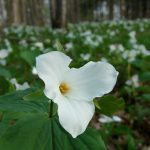You know when you’re driving along the highway for hours and suddenly you have to find a rest stop RIGHT AWAY? Well, birds need rest stops, too!
Imagine you’ve flown all night, heading south to your wintering grounds. In the pre-dawn light you know it’s time to land and rest and refuel. You’re TIRED. So you land at the place you’ve rested every year on this journey, only to find that now your oasis is a parking lot. Where will you find the food that is so necessary to your survival? Where will you find a safe place to rest your weary wings?
Migratory birds face this dilemma every day of their journey. And that journey is in full swing right now. I’ve had 23 different species of warblers passing through my garden so far this fall, mainly because my garden is a lone oasis in a sea of urbanization. At night I can hear the little chirps that are the calls of birds in migration. The hawks are moving south above places like Hawk Mountain in Pennsylvania, and the Canada Geese are filling the daytime skies. I love autumn because I get to see so many different kinds of birds stopping by on their migration.
Your Wildlife Garden can make a huge difference for migratory birds in a sea of shopping centers, business parks, and parking lots.
One third of U.S. birds are in danger of extinction, but there are many things that you can do to help.
During migration, birds need three things:
- Food
- Water
- Safe places to rest
Let’s explore some ideas that you can do to meet each of these needs. I know, every book you’ve ever read about attracting birds spends most of its pages talking about bird feeders: what kinds are best, the best seeds for particular birds, and how to keep squirrels out of them. Many of these books and articles are written by folks who have a financial interest in selling you bird feeders and seed. This is a multi-billion dollar industry each year.
I love my bird feeders because it brings certain birds close enough to me for observation. But we can do so much more for birds by choosing plants that meet their needs naturally.
- You can provide shelter by creating brush piles in a back corner, planting native conifers like pines (Pinus spp), cedars (Juniperus spp), and hollies (Ilex spp), and planting plenty of shrubs to make a thicket or hedgerow.
- Grassland birds need seeds, so plant a meadow of native grasses and wildflowers whose seedheads will provide much needed nourishment and cover to sparrows, bobolinks, meadowlarks,and finches.
- Water can be provided by planting a rain garden, installing a pond with shallow, gently sloping edges, or by providing shallow saucers or birdbaths (make sure these are located where feral or neighbors cats cannot get to them).
- Leave the leaf litter in place under your shrubs. Migrating thrushes and wrens will pick through this in search of insects hiding within. Plus this is the best soil amendment you can get. You’ll not need any fertilizer if you allow the leaves to compost in place to feed your soil
- Plant plenty of tubular flowers for migrating hummingbirds. These include native honeysuckles, salvias, monardas, and lobelias.
- Fruiting shrubs provide a welcome meal to many birds including some warblers, orioles, tanagers, waxwings, and jays. Some of the best are viburnums, hollies, cedars, crabapples, and grapes.
More From Ecosystem Gardening:
Submit your review | |
I ran out of birdfood for about a month and my poor little ?s were just begging and begging..the only thing I had that I didn't think would hurt them was dry oatmeal..THEY LOVE IT..love it better the birdfood..Am I harming them by feeding them this..
I have mainly sparrows..
Thank You








